How To Grow A Straw Bale Garden
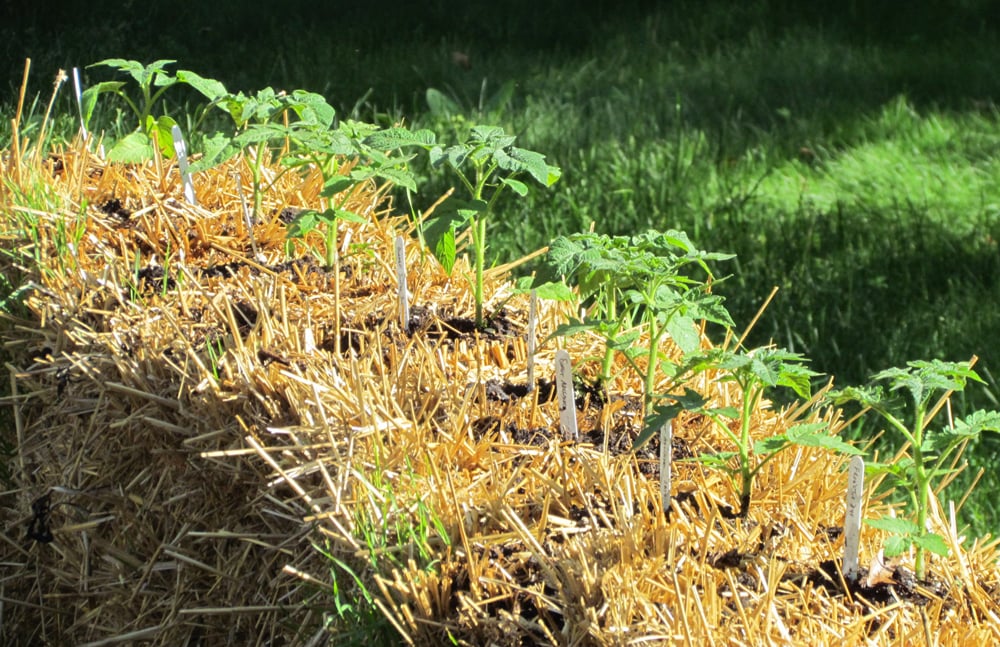 Tomato seedlings transplanted into straw bales, which are set up on a concrete driveway. The plants are dwarf varieties, a good choice for bales. Photos by Craig LeHoullier
Tomato seedlings transplanted into straw bales, which are set up on a concrete driveway. The plants are dwarf varieties, a good choice for bales. Photos by Craig LeHoullier
Consider the humble bale of straw. Think beyond its reputation as a Halloween decoration and picture it as a productive part of your garden. The concept is simple: As the straw begins to break down, it turns into a rich, compostable planter that's ideal for growing vegetables.
Although the practice of gardening in straw bales dates back to ancient times, I learned of it only a decade ago during a chance encounter with a local straw-bale guru, Kent Rogers. When my publisher asked me to write about straw-bale gardening, I tested the techniques in my own gardens and was quite impressed with the results.
Benefits of bales
- The ability to place an instant garden wherever the sun shines
- A way to avoid poorly draining, hard-to-work or diseased soil
- A far less laborious gardening experience, eliminating digging and weeding
Think of the straw bale as a large container with a volume of 40 gallons. Unlike a planter filled with potting soil, the bale begins life as an essentially sterile medium. By season's end, it is transformed into a partially composted mass of organic matter that's teeming with life. After the crops are harvested, the material makes a perfect top-dressing to garden beds or a valuable addition to the compost pile.
Where to start
My advice to beginners: Start small. That way you can see if the technique works well for you. My first year involved a dozen bales, planted with tomatoes, peppers, eggplants, summer squash and cucumbers. In the second year, I expanded to 40 bales, adding lettuce and other greens, leeks, garlic, carrots, beets, radishes and herbs.
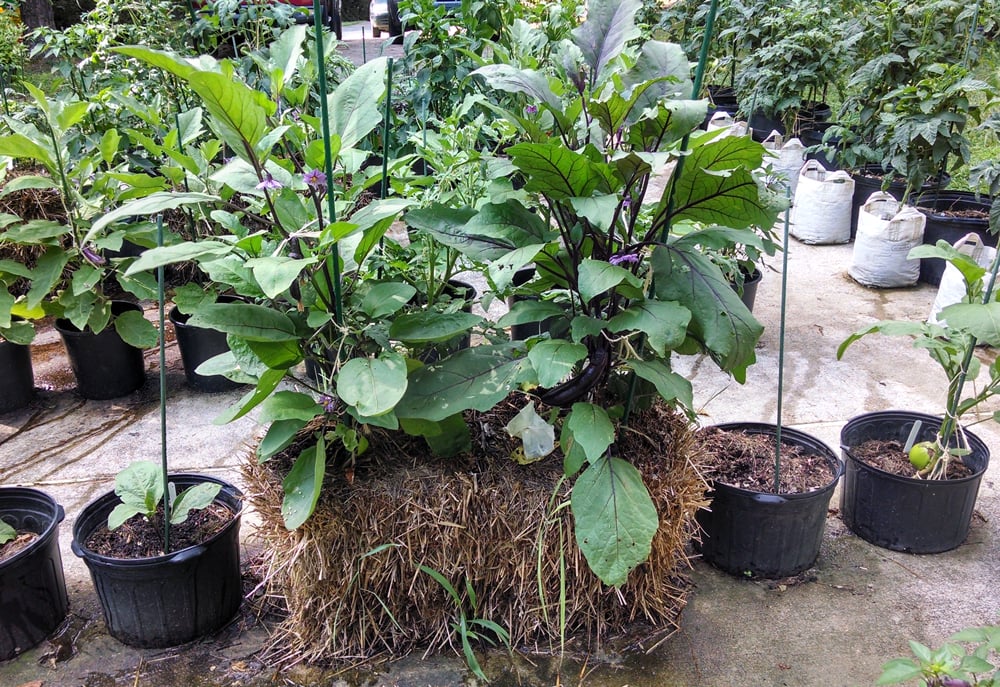 Two eggplants, nearing harvest. This is part of a trial in 2014, which was a big success. Neighboring containers beside the bale were not nearly as big and productive.
Two eggplants, nearing harvest. This is part of a trial in 2014, which was a big success. Neighboring containers beside the bale were not nearly as big and productive.
You can find bales at garden centers. Wheat-straw bales are ideal, though other types such as alfalfa and buckwheat, are reasonable substitutes. Avoid hay bales, which are often quite a bit cheaper. They often include dried grasses with lots of seeds. In addition, they break down too quickly and become weedy. Pine straw does not work well either. It isn't absorbent and it composts too slowly.
Where to put the bales
Vegetable crops need at least eight hours of sun a day. More is better. Make sure you have easy access to water, too. I use bales in my garden and on my concrete driveway. A wet straw bale gets quite heavy, so consider that if you are a rooftop gardener. Wooden decks can be damaged by the constant wetness.
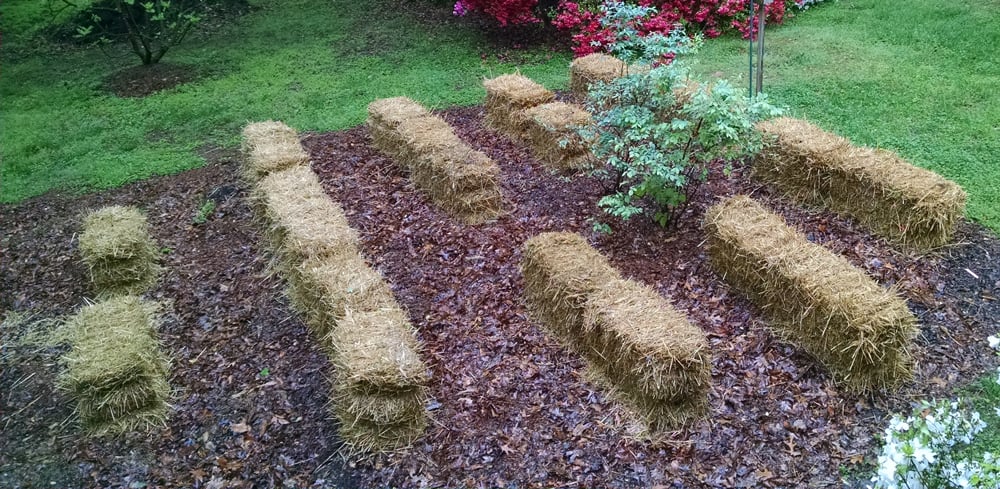 Straw bales ready for the initial preparation. A thick layer of dried leaves forms the platform for these bales — not a shovel in sight.
Straw bales ready for the initial preparation. A thick layer of dried leaves forms the platform for these bales — not a shovel in sight.
What to grow
You can grow crops from seed or plant seedlings — just as you would in a raised bed or in the ground. For seedlings, consider tomatoes, eggplants, peppers and spring greens. If you're planting from seed, start with beans, cucumbers and squash. Carrots, beets, sweet potatoes and potatoes can be grown well but are a bit trickier.
How to prepare the bales
Before you can plant in the bales, they need some special preparation, so buy the bales at least two weeks before you want to plant. Place the bales where you want to grow; once they are prepared, they will be too heavy to move.
Nitrogen sources:
Conventional lawn fertilizer (29-0-4 NPK). Make sure it doesn't include pre-emergent weed-killer. Use 1/2 cup per bale, per application
Blood meal. Use 3 cups per bale, per application.
The first week
- Water the bale thoroughly, until water runs out the bottom of the bale. Sprinkle the surface with a nitrogen source (see box), applying at the recommended rate.
- Every other day, add more of the nitrogen source; water thoroughly. Do it a total of three times during the first week.
- On the days you don't apply nitrogen, just water the bales thoroughly.
The second week
- For the next three days, apply the nitrogen source daily at half the original rate. Follow up with thorough watering.
- After three days of adding nitrogen, water daily.
- At the end of the week, sprinkle each bale with 2 cups of balanced fertilizer, such as organic 5-5-5. Water thoroughly.
Why so much nitrogen? It jump-starts the composting process and creates an ideal environment for plant roots. Over the course of the two weeks, the bales heat up considerably and can reach temperatures of 125 degrees F or more.
After the two weeks of treatment, the bales are ready for planting. The internal temperature should be about 75 to 80 degrees F, which you can verify with a compost thermometer. Probe from side of the bale, about halfway down. Low-tech option: Use your finger. The interior should feel warm, but not hot. If the bale still feels too hot, wait another couple days and check again.
How to plant
To plant seedlings — tomato, pepper, eggplant and greens — make a gap or divot in the top of the bale and set the roots in place. Fill in around the roots with a good-quality, peat-based potting soil, ensuring that the seedlings are well-seated and level with the surface of the bale. Water gently and, if needed, add more soil to fill gaps and stabilize the seedling.
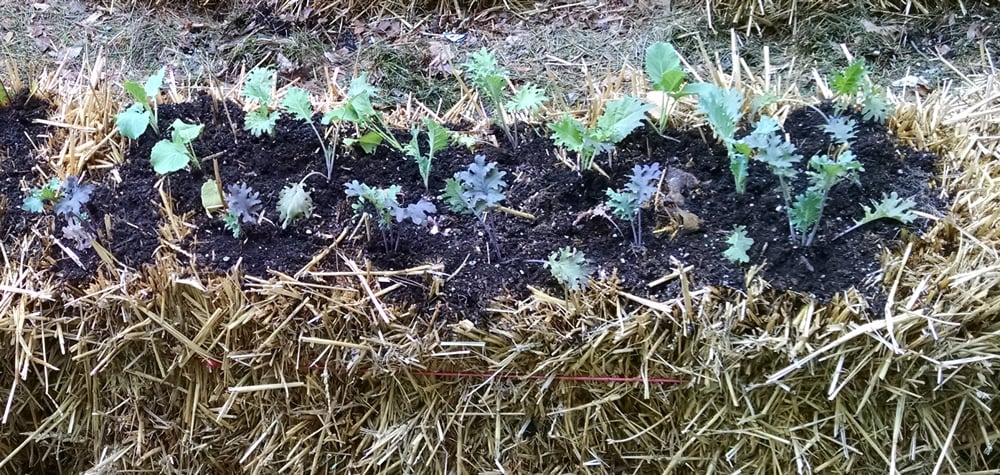 Just planted: red Russian kale and collard seedlings.
Just planted: red Russian kale and collard seedlings.
Plant no more than two tomato, pepper or eggplant seedlings per bale. I've found that all tomato varieties -- indeterminate, determinate and dwarf -- work well in bales. Success depends upon the ability to adequately support them. If you can't provide a tall stake or fencing behind the bale, choose determinate or dwarf varieties. For other crops, use the spacing that's recommended for the variety you choose.
To plant crops from seed, spread a 2-inch layer of moistened, peat-based potting soil on the top of the bale. Avoid bagged "topsoil," which is too coarse for good germination and can become waterlogged. Tamp it down, make it smooth and water lightly. Plant seed at the recommended depth and spacing. Be sure to water regularly during germination.
 Two prepared bales, top-coated with potting mix. Squash seeds will be planted here when warm weather arrives.
Two prepared bales, top-coated with potting mix. Squash seeds will be planted here when warm weather arrives.
Stakes and supports
A good way to support tall plants, such as tomatoes, is with sturdy stakes hammered through the bale and into the ground underneath. Wire tomato cages work for medium-sized plants, such as peppers, eggplants and compact tomatoes, but taller plants can end up a bit unstable as they become laden with the harvest and the bales soften.
When growing in straw bales, it's worth considering compact varieties, which can be surprisingly productive. And when it comes to tomatoes, consider some of the varieties identified by the Dwarf Tomato Project.
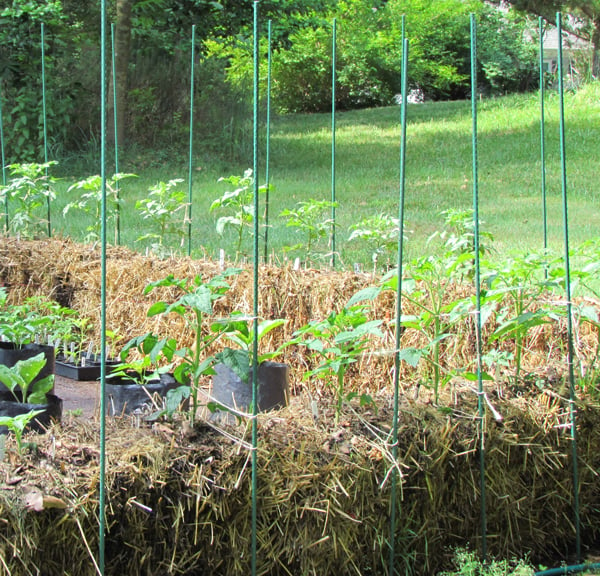 To support tall plants growing in bales that are placed on a hard surface, anchor sturdy stakes to the back of the bale.
To support tall plants growing in bales that are placed on a hard surface, anchor sturdy stakes to the back of the bale.
Care and troubleshooting
Bales can dry out quickly because they are above ground and permeable. Be sure to water regularly. Drip irrigation or a soaker hose, draped across the top, work well.
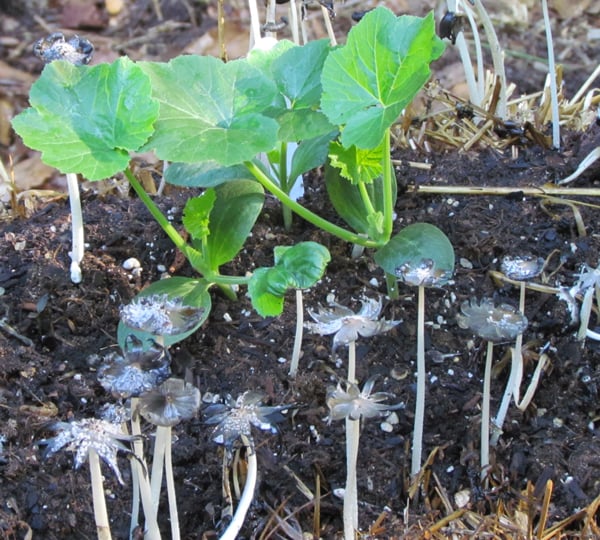 Squash seedlings with mushrooms, which are common early in the season. The harmless mushrooms can be left in place. They will disappear quickly.
Squash seedlings with mushrooms, which are common early in the season. The harmless mushrooms can be left in place. They will disappear quickly.
Similarly, regular feeding is important, because frequent watering will lead to nutrient loss more quickly. Feed your crops once a week with a balanced, water-soluble plant food.
Because the bales are elevated, it helps deter certain critters, such as rabbits. I've found slugs to be a bit of a bother to bush beans. A sprinkling of diatomaceous earth helps with this issue.
By the end of the season, the bales will break down, the extent depends on the crops grown in them and the weather. Some hold up well enough to plant garlic in the fall. Others collapse into a rich mound of compost, perfect for adding to containers, amending garden beds or tossing in the compost pile.
How To Grow A Straw Bale Garden
Source: https://www.gardeners.com/how-to/straw-bale-gardens/8882.html
Posted by: gossforproing.blogspot.com

0 Response to "How To Grow A Straw Bale Garden"
Post a Comment